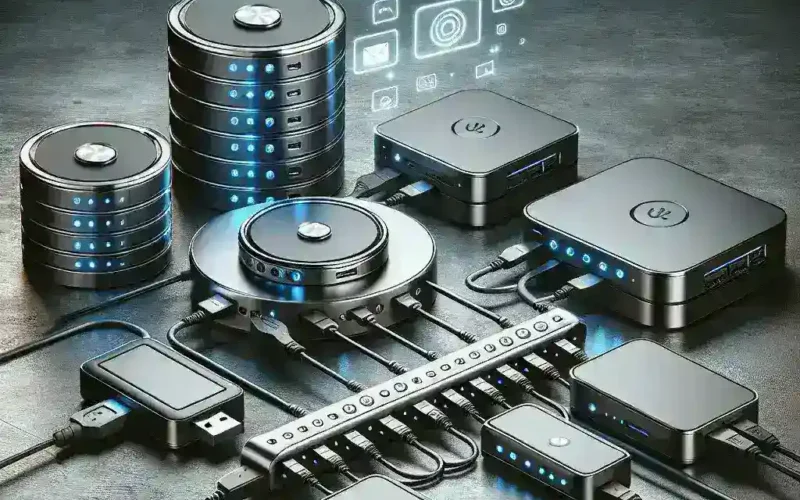As digital media consumption skyrockets, many users are looking for ways to streamline their setups for smoother and more efficient media streaming. One common question that arises is whether or not a USB hub can effectively be used with external hard drives for media streaming. This article delves into the various factors that influence the use of USB hubs with external hard drives, the technology behind it, and tips for optimized performance.
| Aspect | Details |
|---|---|
| USB Hub Types | Passive, Powered |
| Transfer Speeds | USB 2.0, USB 3.0, USB 3.1 |
| Compatibility | Operating Systems, File Formats |
| External Hard Drive Formats | HDD, SSD, Network Attached Storage |
Understanding USB Hubs
A USB hub is a device that expands a single USB port into multiple ports, allowing multiple USB devices to connect to a computer or media player simultaneously. There are two main types of USB hubs: passive and powered. Passive USB hubs draw power from the computer, while powered hubs have their own power supply, providing more stability for connected devices.
Choosing the Right USB Hub for Streaming
When considering using a USB hub for media streaming with an external hard drive, it’s essential to evaluate certain specifications:
- Transfer Speeds: USB 3.0 and USB 3.1 hubs offer significantly faster data transfer rates (up to 5 Gbps and 10 Gbps, respectively) compared to USB 2.0 (up to 480 Mbps). For media streaming, higher speeds ensure seamless playback.
- Powered vs. Passive: If you plan to connect multiple external drives or power-hungry devices, opt for a powered USB hub to ensure adequate power supply.
- Port Type: Ensure the hub has enough ports for your needs while also considering if the device needs USB-C or standard USB-A connections.
- Compatibility: Check that the hub and external drives are compatible with your operating system (Windows, macOS, Linux) and file formats (exFAT, NTFS, HFS+).
Advantages of Using a USB Hub with External Hard Drives
Using a USB hub with your external hard drives can offer several benefits, including:
- Convenience: Connect multiple devices without needing to swap cables. This is particularly useful for users with various media that needs to be accessed quickly.
- Increased Storage: You can expand your storage capabilities by connecting several external drives to a single hub.
- Better Organization: A USB hub can help you keep your workspace organized, reducing cable clutter.
Limitations of Using a USB Hub for Media Streaming
While USB hubs can be beneficial, they also have certain limitations:
- Potential Bottlenecks: If you connect multiple high-speed external drives through a USB hub, you may encounter speed bottlenecks, hindering streaming performance.
- Compatibility Issues: Not all USB hubs support every device type, which could pose a problem when attempting to connect diverse hardware.
- Power Draw: While powered hubs provide more stability, if improperly used or connected with too many devices, they could still face power limitations.
Tips for Optimal Performance
To maximize the performance of your USB hub with external hard drives during media streaming, consider the following tips:
- Use High-Quality Hardware: Invest in reputable brands that guarantee fast transfer rates and reliable power delivery.
- Connect Directly When Possible: For high-demand tasks, such as 4K video streaming, it might be better to connect directly to the computer rather than through a hub.
- Maintain Hub Firmware: Check for and install any firmware updates for your USB hub to ensure optimal compatibility and performance.
- Monitor Power Usage: Be mindful of how many devices you connect to ensure the hub’s power supply is sufficient.
Alternatives to USB Hubs
If you find that a USB hub doesn’t meet your media streaming needs, there are several alternatives:
- Network Attached Storage (NAS): A NAS device can provide shared access for multiple users across a network, eliminating the need for a USB hub entirely.
- Direct USB Connection: If you have several external hard drives, directly connecting them to the computer’s USB ports whenever possible may yield better performance.
- Thunderbolt Docking Station: For those with compatible devices, Thunderbolt docking stations may offer superior speeds compared to standard USB hubs.
Conclusion
In conclusion, using a USB hub with external hard drives for media streaming is certainly feasible and can enhance your digital media experience. However, it’s crucial to consider factors like power supply, device compatibility, and transfer speeds to avoid potential pitfalls. By following the outlined strategies and maintaining awareness of the limitations, users can create an efficient and effective media streaming setup that meets their needs. Ultimately, the choice hinges on your specific use case, available hardware, and individual preferences, allowing you to harness the power of your digital media collection effectively.

